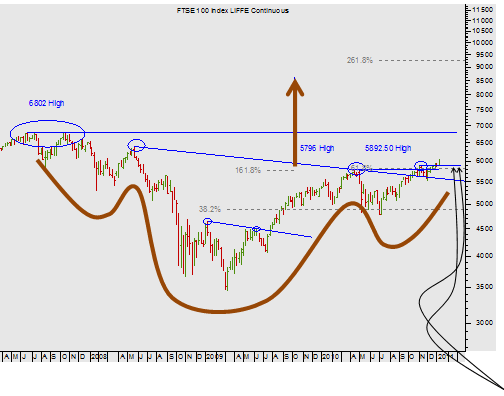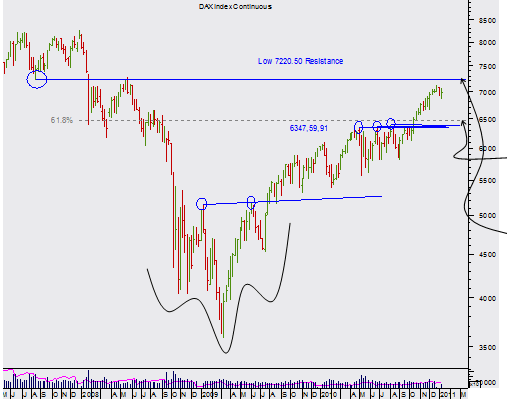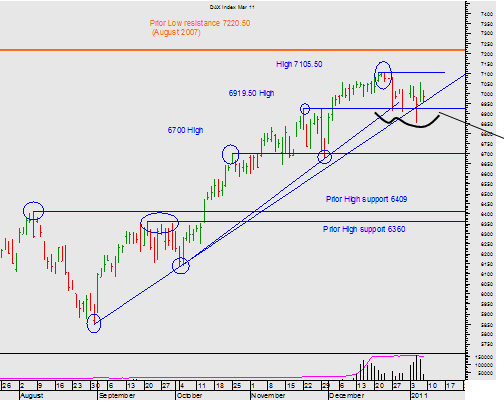The Changing Balance Between FTSE and DAX Stock Indices
Stock-Markets / UK Stock Market Jan 07, 2011 - 07:52 AM GMTBy: Seven_Days_Ahead
 From early September into mid-December the German DAX enjoyed a strong bull run supported by a strong economic recovery, which helped pan-Euro zone economic data mask the plight of many other Euro zone economies that were at best enjoying a modest recovery. Or, more typically, were gripped by the Sovereign debt crisis that has forced Greece and Ireland to seek a rescue. And to shelter under promises made by China to keep buying their Sovereign debt.
From early September into mid-December the German DAX enjoyed a strong bull run supported by a strong economic recovery, which helped pan-Euro zone economic data mask the plight of many other Euro zone economies that were at best enjoying a modest recovery. Or, more typically, were gripped by the Sovereign debt crisis that has forced Greece and Ireland to seek a rescue. And to shelter under promises made by China to keep buying their Sovereign debt.
The FTSE has rallied too, but the move has been less dynamic. Even though UK Q3 GDP grew by 0.7%, following an even stronger Q2 GDP report of 1.1% or 4.4% annualised, which is more than respectable. But unlike the DAX, the FTSE suffered a steep correction throughout November.
Yet for all that, over recent days the FTSE has pushed higher, just when UK data has begun to support the fears of many analysts that the UK economy could struggle in 2011. And now, the DAX is now showing signs of fatigue if not vulnerability even though German data remains almost uniformly positive.
For answers to this growing divergence from previous trends we must look beyond the UK and German economies. In the case of the DAX, the Euro zone economy is under close scrutiny as the Sovereign debt crisis continues to rumble on. The Germans have turned down requests to allow the issuance of Pan-Euro zone debt in place of national Euro denominated debt as a means of solving the crisis. Moreover they continue to push for hasher terms to be applied to any new bailout requests from failing Euro zone member states.
The story now on many lips in the markets is: can the Euro zone survive at all or in a reduced state, with or without Germany. Germany seems to think the way forward for the Euro zone is for all member states to adopt the German export-led, suppressed domestic demand economic model.
This model may work for Germany since it already has established world-class export manufacturing industries that fuel growth and allow her to run large trade and current account surpluses. But what do the majority of the peripheral states have to offer that would allow them to adopt this economic model? We think very little and the result would be years of deflation and austerity.
But what of the FTSE? The UK is implementing one of the most severe austerity programs ever, with public spending slashed and VAT hiked. So severe is this program that there are real fears the economy will not be able to cope, but this environment isn’t retarding the FTSE. Why?
Over recent weeks the US economy has begun to publish strengthening data, and many now judge the US economy is about to emerge from the long period of economic under performance that forced the Fed to start a QE2 policy and Obama to agree to an extension of the Bush tax cuts.
The result could prove dramatic. If the US economy can join the Chinese and Indian economies and start to experience strong growth, demand for raw materials and energy will move up to a level never before witnessed. That is because this would be the first economic cycle where the US has two new large nearly-emerged economic powerhouses competing for market share.
Over many years FTSE has evolved from being a parochial stock exchange to an international market place where many foreign companies seek either a primary or secondary listing. This is the advantage the FTSE has over the DAX. Consequently, as demand grows internationally for energy, raw materials and commodities of all types, the companies that supply them will see their equity in demand and this will help underpin the strength of the FTSE.
This year then could well see the FTSE outperform the DAX even though the UK economy may underperform her German counterpart.
The Technical Trader’s view:
|
FTSE MONTHLY CHART The FTSE is very well set-up. A large Head and Shoulders pattern has completed and looks to be driving the market better – as far as 8500 or so. In the short and medium-term too, the price action is compelling for the bulls - see how the market has overcome both the Prior Highs at 5796 and 5893. ( and a Fibonacci resistance) Both these Highs will be powerfully supportive on any pull-backs |
|
DAX WEEKLY CHART In many respects the DAX has been ahead of the 2009 rally in the FTSE, having overcome the same 61.8% retracement resistance weeks earlier, but the clear over head price action resistance and resistance from the Prior low at 7220.50 is a warning to the Dax bulls. Also, there is no equivalent underpinning to the H&S reversal pattern in the FTSE. |
|
DAX DAILY CHART The sideways price action throughout December is clear and notable. The drift has taken the market back to the support from the Prior High in Late November …. |
|
FTSE DAILY CHART But the FTSE is a great deal higher than it was in early December, bouncing from the support of Prior Highs in the manner of a well-constructed bull trend. |
Mark Sturdy
John Lewis
Seven Days Ahead
Be sure to sign up for and receive these articles automatically at Market Updates
Mark Sturdy, John Lewis & Philip Allwright, write exclusively for Seven Days Ahead a regulated financial advisor selling professional-level techni44cal and macro analysis and high-performing trade recommendations with detailed risk control for banks, hedge funds, and expert private investors around the world. Check out our subscriptions.
© 2010 Copyright Seven Days Ahead - All Rights Reserved
Disclaimer: The above is a matter of opinion provided for general information purposes only and is not intended as investment advice. Information and analysis above are derived from sources and utilising methods believed to be reliable, but we cannot accept responsibility for any losses you may incur as a result of this analysis. Individuals should consult with their personal financial advisors.
Seven Days Ahead Archive |
© 2005-2022 http://www.MarketOracle.co.uk - The Market Oracle is a FREE Daily Financial Markets Analysis & Forecasting online publication.







